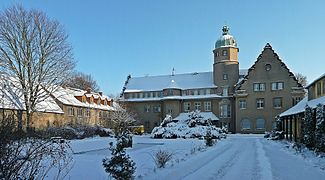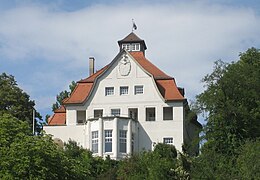William Lossow
Walther William Lossow (born July 21, 1852 in Glauchau ; † May 24, 1914 in Heidelberg ) was a German architect .
Live and act
William Lossow was the third of four children of the businessman Emil Lossow and his wife Marie Emilie Albertine Lossow nee Walther. His brothers were Arthur Lossow and Max Lossow . He studied at the Chemnitz Higher Trade School and at the Dresden Polytechnic until 1878 . There he was a member of the Corps Thuringia .
While still studying engineering, Lossow discovered his passion for architecture and switched to the Dresden Art Academy under Karl Weißbach . After graduating in 1878, he spent a year studying in Italy.

After his return, Lossow opened the joint architecture office Lossow & Viehweger in Dresden with the architect Hermann Viehweger in 1880 , which existed until 1906. Lossow & Viehweger concentrated on the design of historicist villas, residential buildings and commercial buildings in Dresden and the surrounding area. The style was initially assigned to historicism . Later, elements of the Baroque were also taken up, making it easier to classify the buildings in the historic Dresden cityscape. After 1900, however, there were also influences from contemporary reform architecture .
After the Lossow & Viehweger office community was dissolved in 1906, Lossow worked with his son-in-law Max Hans Kühne (1874–1942) until his death . During this time, numerous important public buildings, sacred and industrial buildings as well as residential and manor houses were built, which are characterized by contemporary functionality, sensitive choice of materials and effective design.
In 1906 he was chairman of the exhibition board of the Third German Applied Arts Exhibition in Dresden , at the opening of which he led the exhibition together with Cornelius Gurlitt , King Friedrich August III of Saxony and Prince Johann Georg .
One of the best-known works of the Lossow und Kühne (also Lossow & Kühne ) office is Leipzig Central Station , which was built between 1909 and 1915 with the participation of then employee Rudolf Bitzan as Europe's largest terminus to this day.
William Lossow died of kidney disease in Heidelberg in 1914.
Private
Lossow had been married to the Glauchau factory owner's daughter Johanna Maria Gertrud Kratz since 1880. The marriage resulted in the daughter Hanna and the son Wilhelm Herbert.
Offices
- Director of the Dresden School of Applied Arts (1906–1914)
- Chairman of the preparatory committee for the 3rd German Applied Arts Exhibition in Dresden (1906)
- Chairman of the Dresden Arts and Crafts Association
- Board member of the Saxon State Office for Applied Arts (since 1906)
- Member of the supervisory board of the bank for buildings in Dresden
Buildings (incomplete)
Lossow and Viehweger
- 1885–1887: Villa Eduard Hielle in Schönlinde (Northern Bohemia)
- 1891–1892: "Victoria House" in Dresden (destroyed)
- 1893–1894: Town hall of Plauen (near / in Dresden)
- 1896–1900: Garrison Church of St. Martin in Dresden's Albertstadt
- 1899–1901: Electricity and district heating plant in Dresden (west of the Semper Opera House, not preserved)
- 1901–1902: Protestant Resurrection Church in Dresden-Plauen
- 1902: Lossow's own house in Dresden, Tiergartenstrasse 52
- 1902: Müllerbrunnen in Dresden-Plauen
- 1903: Elstra Castle
- 1904: Herzfeld department store on the Altmarkt in Dresden
- 1905: Building of the Kieler Latest News on the Fleethörn in Kiel (rebuilt after the Second World War in a simplified way)
- 1903–1907: Dresden School of Applied Arts and Arts and Crafts Museum
Lossow and Kühne
- 1907: "Preußenhaus" in Tübingen
- 1908: Geitner-Stadtbad in Schneeberg (Ore Mountains)
- 1908–1909: Protestant church in Zinnwald (Ore Mountains)
- Competition 1909, built 1910–1911: Synagogue in Görlitz
- Competition 1910, built 1912–1913: New Royal Theater in Dresden
- 1909–1910: Estates building in Bautzen
- 1909–1913: Malter dam
- 1909–1915: Leipzig Central Station
- 1910–1911: Main buildings of the 1911 International Hygiene Exhibition in Dresden
- 1910–1911: Manor of Helmsdorf Castle
- 1911: Publishing house of BG Teubner Verlag in Leipzig
- 1911–1912: Spinning mill of the Johann Priebsch Erben company in Untermorchenstern (Bohemia) (today: Dolní Smržovka , Czech Republic)
- 1911–1913: Dresden State Theater
- 1912–1913: Bienert's harbor mill in Dresden-Friedrichstadt
- 1912: Villa Tiergartenstrasse 50 (Strehlen)
- 1913: Protestant chapel in Oberbärenburg
- 1913–1915: Hotel "Astoria" in Leipzig (at the main train station)
- 1913–1915: Chamber of Commerce and Industry in Plauen (Vogtland)
- 1914: "Saxon House" at the German Werkbund exhibition in Cologne 1914 (not preserved)
The later work of the Lossow & Kühne office can be found at Max Hans Kühne .
Tübingen: House of the Corps Borussia Tübingen (Preußenhaus) on the Neckar side of the Österberg
Individual evidence
- ↑ text ilka Johann Priebsch heirs (první) - tzv. Obnovená. In: Architektura českých Němců 1848–1891 | Architecture of the Germans in Bohemia 1848–1891. Retrieved March 24, 2020 .
literature
- Hartmut Gräfe: On the work of the Lossow & Kühne architectural association in Saxon Switzerland. in: Landesverein Sächsischer Heimatschutz (Hg.): Calendar Sächsische Heimat 2017, calendar sheet 36th week
- Nekrolog in: The art chronicle. Weekly for arts and crafts. NF 25, 1914, col. 542.
Web links
- Matthias Donath : William Lossow (1852-1914) . In: Institute for Saxon History and Folklore (Ed.): Saxon Biography .
- Entry in Stadtwiki Dresden
- Otto-Heinrich Elias : From Historicism to Modernism. The career of a successful architect. at www.glauchau.de , last accessed on January 11, 2020
- Illustration copper engraving of King Friedrich August III. von Sachsen with Prince Johann Georg, architect and exhibition president William Lossow, art historian Cornelius Gurlitt and others at the 3rd Dt. Applied arts exhibition in Dresden 1906 in the online collection of the Staatliche Kunstsammlungen Dresden
| personal data | |
|---|---|
| SURNAME | Lossow, William |
| ALTERNATIVE NAMES | Lossow, Walther William (full name) |
| BRIEF DESCRIPTION | German architect |
| DATE OF BIRTH | July 21, 1852 |
| PLACE OF BIRTH | Glauchau |
| DATE OF DEATH | May 24, 1914 |
| Place of death | Heidelberg |







